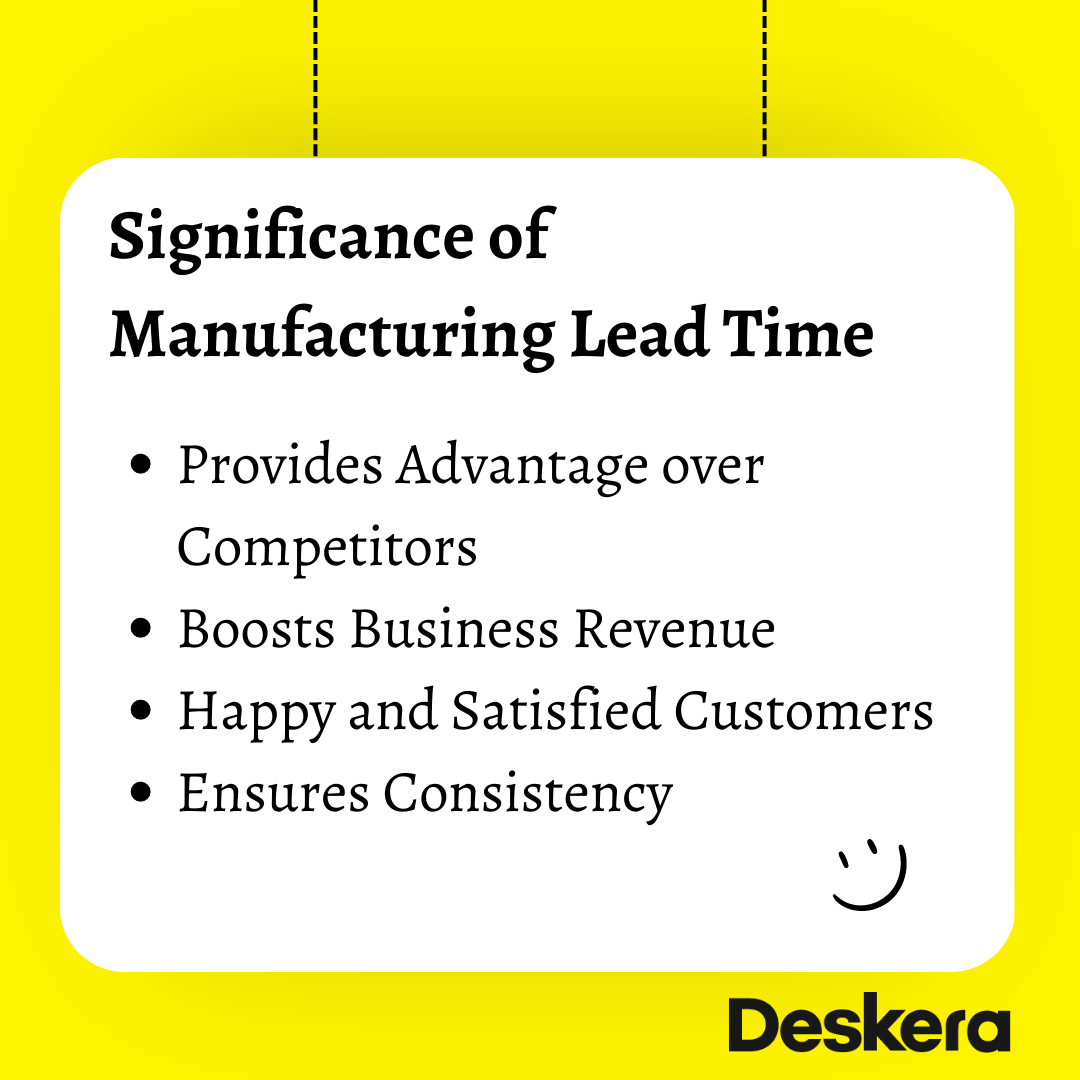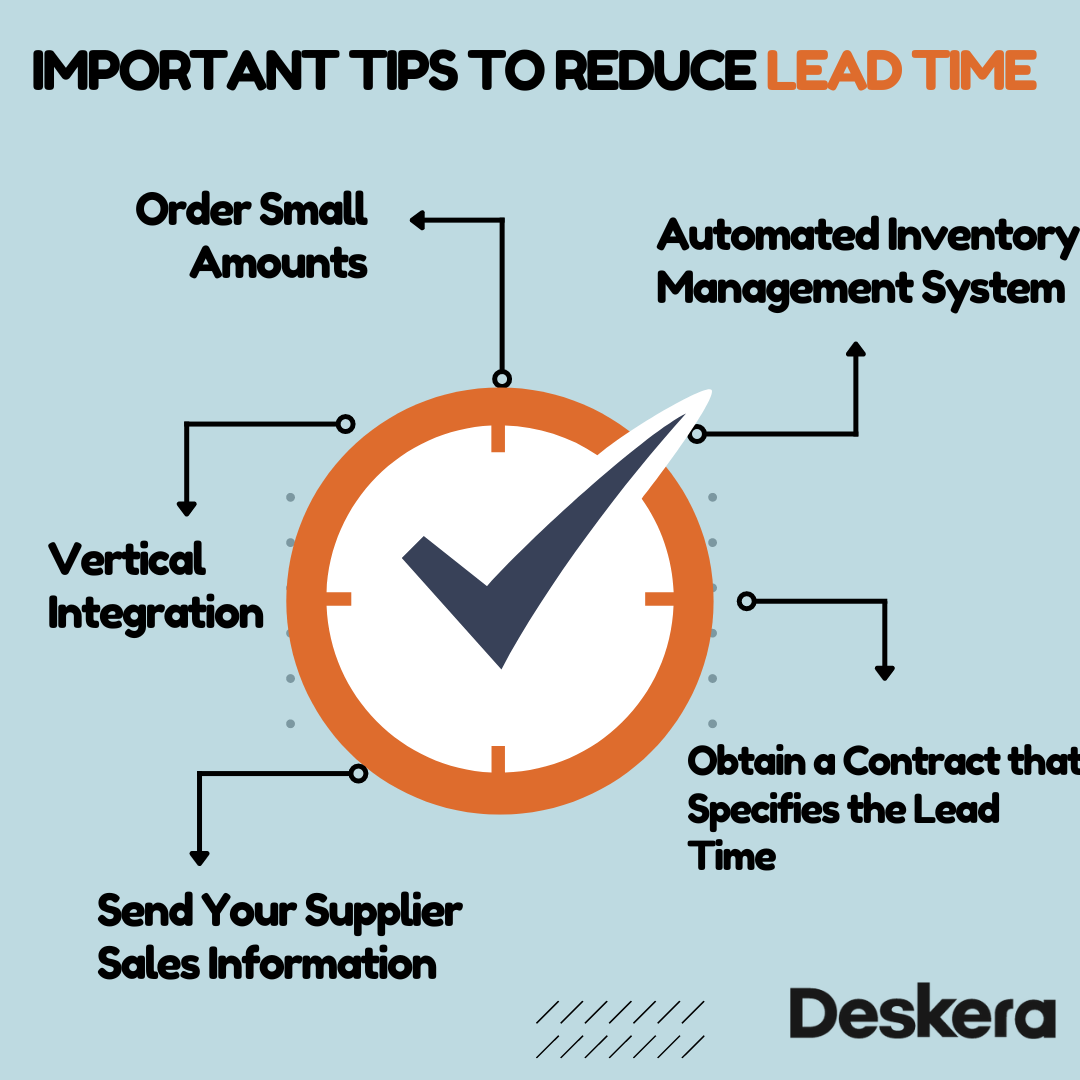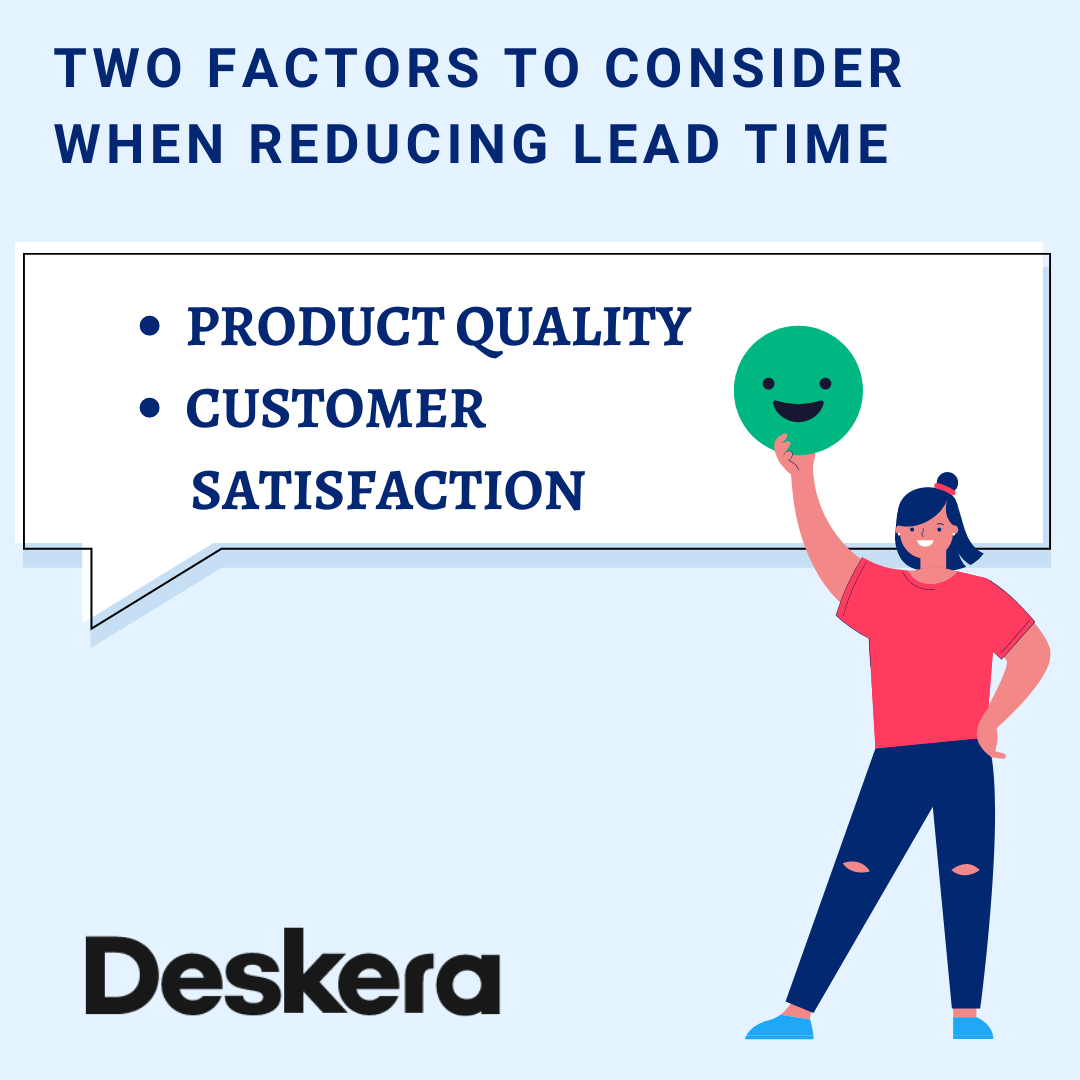Every importer must reduce the manufacturing lead time in order to release new products onto the market. If the importer launches their products at the right time, they can outsell the competitor with greater offerings.
Manufacturing lead time is a crucial consideration when using a variety of resources to optimize the replenishment process in business. You must ensure that stock and production are moving as much as feasible.
In order to reduce manufacturing lead time while importing goods, you can read a detailed description of manufacturing lead time and its essential elements here.
Before we dive in, let’s take a look at the table of content:
- What is Manufacturing Lead Time?
- Manufacturing Lead Time Factors
- Significance of Manufacturing Lead Time
- Some Other Types of Manufacturing Lead Time
- Calculating Lead Time in Manufacturing
- Lead Time Manufacturing Calculator
- Example of Manufacturing Lead Time
- What are the Benefits of Reducing Lead Time?
- Important Tips to Reduce Lead Time
- What are the Major Factors that Affect Lead Time?
- Difference between Lead Time and Cycle Time
- Two Factors to Consider When Reducing Lead Time
- Frequently Asked Questions (FAQs) on Lead Time Manufacturing
- Final Thoughts
- How Deskera Can Assist You?
Let's Begin!
What is Manufacturing Lead Time?
Manufacturing lead time is the time it takes to produce a product or service. It includes the time duration from the start of the manufacturing process to the point where the product or service is ready for delivery.

This time can be affected by a variety of factors, including:
- Complexity of the product or service,
- Availability of raw materials,
- Number of production steps involved,
- Availability of labor and machinery, and
- Size of the order.
The lead time is the period of time between making a stock order and getting the products to meet consumer demands. With enough lead time, the importer can put up stock for your products before it runs out.
For instance, you might place an order for extra items if you have a supply that is about to run out. The time it takes to rearrange the stock is referred to as the manufacturing lead time.
A long time between placing an order and delivering the product will be bad for your business and good for your competitors.
Consumers wants their products delivered as quickly as possible; thus, you will lose customers and sales if you are unable to accomplish so on time.
Manufacturing Lead Time Factors
The majority of manufacturing lead time factors are controllable by businesses. During this internal-only stage of the sales process, a company may change its practices, personnel, or tools to shorten or lengthen lead times.
Contrary to the other two lead time aspects, a company should have virtually total control over the manufacturing lead time factors.
There are many factors that contribute to longer lead times, including:
- The layout or location of the processing plant(s) is/are inefficient.
- The company offers subpar electricity or utility services.
- The company has trouble locating enough skilled staff.
- The company has trouble getting finished goods out of its warehouse on schedule.
- A challenge for the company is governmental legislation that delays or influences the manufacturing process.
- The need for routine maintenance or equipment failure slows down the production process.
- The company is expecting specialized or unique components needed to create a good.
- The company must adjust its products due to low quality.
Significance of Manufacturing Lead Time
An important aspect of international transportation and trade is the production lead time. It won't be helpful unless the impact of this aspect gets reduced.
Following, we go over some possible commercial uses for quicker manufacturing lead times.

Provides Advantage over Competitors
Manufacturing lead time is a key element in determining a company's ability to remain competitive in the market.
By reducing the lead time, you may produce things more rapidly and effectively to compete in the market. It raises the bar for your businesses and increases profits.
Boosts Business Revenue
Lead time is essential for increasing business turnover. If your consumers are satisfied with the fulfilment and delivery of their orders, you will draw in additional sales and loyal customers, boosting your income and profit.
Happy and Satisfied Customers
Every customer who has placed an order want to get their product as soon as possible. Customers will always favor companies that use the least amount of effort to deliver their goods.
Therefore, the length of the production process has a significant impact on how satisfied clients are. It also makes it easier to build long-lasting ties with customers.
Ensures Consistency
When lead times are correctly planned, deadlines can be met smoothly and regularly. Additionally, it is essential for market rivalry and flexibility improvement, particularly during sudden and unforeseen market transitions.
Some Other Types of Manufacturing Lead Time
There are different lead times, which we must be aware of. Four primary forms of lead time exist for the manufacturing process. The details of the types are as follows:
1. Material Lead Time
It is the period from the time an order is placed with a supplier until the finished product is received. Between receiving an order and getting an order confirmation is the ordering period.
2. Customer Lead Time
It represents the span of time from the moment the customer confirms their order till the order is processed and then delivered or picked up. This is governed by the customer's choice and the conditions of the contract.
3. Production/ Manufacturing Lead Time
It is the amount of time required to prepare and deliver a product when all the required resources are available.
4. Cumulative Lead Time
The entire time it takes for an order to be accepted, shipped to the provider, and received is when you have to order all the goods. The two procedures known as manufacturing lead time and material lead time must be added.
5. Throughput Time
We'll start by talking about throughput time, a technique for calculating how quickly and effectively resources and goods move through your production system. Another name for it that is frequently used is cycle time.
To make sure everything is running as effectively as possible, throughput time essentially evaluates the entire manufacturing process. If there is a bottleneck in your system, you should locate it and resolve it.
The following are some of the things a typical throughput time study considers:
- Process time
- Inspection time
- Move time
- Wait time
It is split down as follows practically:
Process time is the total amount of time required to create a product.
The inspection time is the length of time that passes after manufacturing is finished before the finished product is examined.
A finished product's transit time from production and inspection to the warehouse, where it will remain until an order is placed, is measured by the move time.
The time a product spends in a warehouse before being delivered to a customer is the final component of wait time.
If you want to apply lean manufacturing principles to your business, you should thoroughly review your throughput time. Time savings at each level could have a big impact.
6. WIP and Production Lead-time
The next two are WIP and production lead-time.
All of your products that are currently being created but aren't yet ready to be added to your inventory that is currently for sale are referred to as "work in progress" (WIP).
It's important to note that if you know your WIP lead-time, you can use the following technique to get your production lead-time:
The average production rate multiplied by the number of active projects results in lead-time.
Here is an example:
If you are now manufacturing 750 widgets at a rate of 25 widgets per day, your lead time is 30 days.
750/25 – 30.
Of course, the time it takes for your work in progress to be finished will vary, but this may give you a general idea.
The main goal here is to have a rough understanding of how long manufacturing and assembly take.
Calculating Lead Time in Manufacturing
To calculate the specific amount of time needed for the manufacturing process, make a list of every item needed for the conceivable activity.
The following essential steps must be taken in order to determine the correct lead time in manufacturing.
Bill of Materials (BoM) Plan
Determine how much of each material is needed for each Bill of Material (BOM) element by making a list of all the materials needed to make the finished product. The list will include the necessary equipment, materials, and assembly instructions to create finished goods.
Compute Administrative Lead Time
Calculate how long it will take from the time a material order is placed until the BOM items are expected to arrive. You must take into consideration the supplier's demands for, processing of, and transportation of raw supplies when calculating this time frame.
Calculate The Inter-Operational Time
In this stage, you will choose the lead time for interoperations. The time it takes for a task to move from one work center to another while being processed can be calculated here.
Each individual component, such as the wait time, post-operation wait time, and queue time, should be examined, included, and added.
Determine the Total Production Lead Time
You can now get the total lead time for the production process by adding the lead times for each phase and figuring out the total duration. This entire amount of time will be used to determine the actual lead time for producing a certain product.
Lead Time Manufacturing Calculator
To estimate how long it will take to process a piece of merchandise, use the lead time calculator below. You can inform clients of the general delivery time of their products in this way.
It could be hours, days, or even weeks. Everything depends on the techniques you employ.
However, generally speaking, this is the formula you'll use to calculate your manufacturing lead time (MLT):
This creates the framework needed to begin increasing your productivity and cutting down on your lead time.
But in order to take advantage of it, you must fully comprehend the concept.
Lead time in manufacturing refers to the period of time required for order processing, material preparation, manufacture, and delivery. There are typically three of them:
- Pre-processing (minutes, hours or days);
- Processing (minutes, hours or days); and
- Post-Processing (minutes, hours or days)
Pre-processing is the amount of time needed to handle the order, create the sales order, and prepare the items; Preparation begins with preprocessing. Even if no work has been finished at this stage, your purchase orders are still sent out.
The processing period is the time between placing and picking up the order. Cycle time is another name for it; and
Processing lead time, sometimes referred to as throughput time, is the challenging part. It is the period of time required to create or acquire a requirement. Consequently, it is the usual duration of:
- Materials to come in;
- Processes to get done; and
- The waiting times in between.
Post-Processing is the time for delivery.
Example of Manufacturing Lead Time
In order to demonstrate lead times, I'll use the toy helicopter as an example.
You must first account for pre-, during-, and after-processing times when calculating lead time.
Taking the customer's order, counting how many orders were placed that day, and forwarding manufacturing requests to sales are all included in pre-processing time. You must account for all the time necessary to complete these jobs. Pretend you'll need 15 minutes to complete it.
The processing phase follows, which will entail cycle time and be estimated to take 10 minutes.
Let's say you transport toy helicopters to homes. It implies that the delivery lead time will be included in the post-processing stage and that the products will be delivered in a day. The total time is now calculated.
Pre-processing time= 15 minutes
Processing time= 15 minutes
Post-processing time= One day (1440 minutes)
Lead time(manufacturing)= Preprocessing time + processing time + postprocessing time
Lead time = 15 minutes + 15 minutes + 1440 minutes
Lead time = 1470 minutes
It implies that you will require a total of 1470 minutes to deliver the product to the clients. Lead times can also be calculated in terms of hours and days, depending on the complexity of the product and the distance from the source.
What are the Benefits of Reducing Lead Time?
Due to the desire of many manufacturing industry firm owners to increase production speed, all organizations must reduce lead times. It will considerably increase supply and demand flexibility and reduce the amount of time spent waiting for items to arrive.
Management and the manner you communicate your requirements to suppliers have an impact on lead times. If your propensity is to reduce lead times, you should focus on both ends.
Listed below are some benefits of reducing lead times.
Enhance Output
Everyone understands that growing sales will result in greater profit. Getting rid of long lead times will boost earnings at your organization. Higher output and higher turnover will be the results of a shorter lead time.
Prevents Deadstock
When a customer orders a product and it takes longer than anticipated for whatever reason, the buyer starts looking for alternatives.
The consumer will have less time to find other options the longer it takes for the goods to reach the warehouse. When a product reaches its intended location, it becomes a dead stock.
If there is an excess of deadstock, the company's financial resources will be put under pressure. There will be an effect on the budget plan. Business balance sheet and cash flow.
Become More Flexible
It is possible to observe stock variation better with a shorter lead time. It means that you may understand both the production process and market demands thanks to it.
You can understand market changes because to it.
Increase of Production Time
It is possible to shorten the lead time, which will hasten production. It will do away with needless tasks, hold-ups, and waste in numerous processes. With good management, lead times can be reduced, and manufacturing times can be improved.
Important Tips to Reduce Lead Time
Following are a few suggestions you can employ to cut the production lead time. Let’s learn:

1. Order Small Amounts
Large orders will take longer to produce and ship. It will be better if you make fewer, smaller orders more frequently.
This strategy will assist in regularly updating the stock management. The smaller amounts will also help to lessen market competition.
What would happen if you made a significant order, but the market's demand fell? Dead stock will follow, which will have an effect on the company's budget.
If you only place significant orders when it's time to replace supplies or materials, you could accidentally increase the amount of time it takes to fulfill those orders.
Instead of completing a single huge transaction, think about using a more flexible approach and segmenting your invoices into smaller amounts.
Your supplier will be able to finish your orders more quickly as a result, and you'll be able to reduce your lead time—possibly significantly.
If you're not getting a discount for bulk orders, choosing smaller, more frequent orders will actually help you shorten the wait time for manufacture. One of your primary priorities should be this.
Additionally, it will be straightforward for producers to develop and distribute products rapidly.
2. Automated Inventory Management System
If you want to take the direct fix and reduce the likelihood of human mistake that materializes if there are several spreadsheets involved, think about investing in inventory management software.
Automating your inventory management system is preferred because human mistake is unavoidable. We occasionally make errors in our listings due to managing several vendors. Manual spreadsheet creation carries the possibility of error.
Therefore, if you want to lower risks and errors, automation is a necessity. A computerized system could also help you by alerting you when a product is being reordered so you can place a new order.
You may manage your supply chain much more simply by using the software that is offered in every price range.
3. Obtain a Contract that Specifies the Lead Time
Every supplier you work with needs to be covered by a contract, and that contract needs to be extremely clear about the penalties for late or damaged shipments, delays, and other similar occurrences.
When placing an order, make sure to keep lines of communication open with your suppliers so you may offer him detailed instructions. After making your final choice, enter into a contract with a clear lead time that includes penalties for delays or damaged goods.
Include a notice alerting customers to any changes in cost, availability, or discontinuation.
You should also outline the conditions for price modifications and discontinuation announcements to prevent being caught off guard.
The absence of a defined contract can lead to delays. Delays can have a significant negative impact on your company's lead time.
4. Vertical Integration
If your organization has a lot of resources—including people, space, cash, and equipment—it will profit most from a vertical integration idea.
It gives internal sourcing, production, and assembly significant consideration. It will give vendors more information about your company.
Furthermore, you will match market expectations in the shortest amount of time because your organization has total control over all the variables.
5. Send Your Supplier Sales Information
Have you considered making your sales data accessible to your suppliers? You haven't most likely.
Companies that see their suppliers as partners see greater growth than other businesses. The reason is that by giving your suppliers sales information, you help them understand market demand better.
Nevertheless, giving your suppliers access to sales data not only helps them feel like valued partners in your commercial endeavors, but it also educates them on how your organization runs. Because of this, they can anticipate needs before you even contact them.
The manufacturer sends you the goods as fast as they can because they are mindful of both market and consumer expectations.
Working with vendors who are aware of your business and foresee your demands will drastically reduce your lead time.
What are the Major Factors that Affect Lead Time?
It is evident that cutting the lead time will boost an organization's productivity, turnover, sales, and revenue in addition to the manufacturing sector's productivity. But it's essential to comprehend the elements influencing lead time.
Therefore, by comprehending these components, the production process can be optimized. The typical influences on lead time are listed below.
Stockouts
A stockout is a situation in which a business runs out of an item that it needs to make a product or fulfill an order. This can be a disaster in manufacturing, as it can lead to significant delays in production and can cause customer dissatisfaction.
A stockout is the worst-case situation for manufacturers since it makes it impossible to produce goods when there isn't enough inventory or essential components on hand.
Lead times will increase, but it will also enrage and irritate your customers. Additionally, they risk losing customers and sales if they decide to explore elsewhere for new items.
Stockouts can also lead to lost sales and lost revenue, since customers may turn to competitors if they cannot get the product they need when they need it. Additionally, a stockout can cause disruptions to the supply chain, which can lead to further delays and cost overruns.
To solve the problem and guarantee that you get notifications in a timely manner, you can automate your inventory management system.
Shipping Delays
It is the hardest and most unpredictable production process variable to control. The delivery delay will result in a shortage of raw supplies.
Shipping delays in manufacturing can be caused by a variety of factors, including poor planning, inadequate coordination, inadequate staffing, equipment failure, or unanticipated weather events.
In some cases, delays can be prevented by improving communication between the manufacturing facility and the shipping partner, ensuring that all orders are accounted for and that the necessary shipping materials are in place prior to the start of production.
Additionally, manufacturers should ensure that their equipment is in good working condition and that their staff is adequately trained to handle the workload.
Moreover, you can have some influence over this aspect by identifying vendors in your area. By keeping an eye on supply and demand, you can also choose a supplier who maintains a ready supply of goods.
Finally, manufacturers should stay up to date on weather forecasts and plan shipments accordingly.
Inefficient Inventory Control
The inventory management system has a significant impact on both lead time and the manufacturing process. If the inventory control system is out of control and there is employee negligence, lead time may worsen.
Inefficient inventory control can be defined as the management of inventory that fails to optimize the inventory balance between costs and customer service. It can result in too much or too little inventory and can lead to increased costs and decreased customer satisfaction.
Poor inventory control can be caused by a lack of visibility and accuracy of inventory data, over-ordering, under-ordering, and inadequate tracking of inventory movements.
To address inefficient inventory control, organizations should focus on collecting accurate inventory data, setting appropriate inventory levels, and tracking inventory movements.
Accurate data can be collected through automated systems such as barcode scanners and RFID tags, while appropriate inventory levels can be determined by analyzing past sales trends and customer demand.
Organizations should also track inventory movements in order to identify areas of inefficiency and adjust accordingly. By implementing these strategies, organizations can achieve an optimized balance between costs and customer service.
Better inventory control reduces inventory costs, increases sales and clientele, and prevents dead stock. It ensures what stock is on hand, in what quantity, and what is coming up next.
Enhance Your Service
Lead time can be lowered by motivating internal and external stakeholders, such as suppliers and employees, by setting goals and expectations and rewarding those who meet them.
Despite increasing a company's costs, the potential increase in sales volume can surpass the bonus or incentive payments necessary to move merchandise more swiftly.
Unnecessary Processes
You must be more informed if you want to shorten lead times and work more effectively. It will take longer to fulfill orders if you produce each component of the final assembly. Therefore, dead goods will continue to be sold since the customer will find a substitute.
By purchasing some subassembly components from other companies, the manufacturing process can be made more effective and the manufacturing time can be decreased. Customers will be pleased as a result, and manufacturing will move more quickly with shorter lead times.
Carrying More Inventory
Carrying more inventory is linked to a higher risk of theft or obsolescence, which raises storage, security, and insurance expenses. Instead of needing to wait for shipments, a business can run smoothly if it has inventory on hand.
Tracking Transportation Method
Not all transportation options are created equal; some may merely be better options.
Due to unanticipated circumstances like labour shortages, natural disasters, or legislative changes, whatever may be wonderful this month may need to alter. This relationship is likewise dynamic.
A company should continually monitor the shipping methods it and its suppliers use to see if there are any more effective alternatives.
Lack of Personal Growth
The level of employee training affects how well the internal manufacturing process works.
Businesses that place a high priority on cross-training and learning opportunities may benefit from stronger labour markets and staff that are more trained and proficient in the process.
Inaccurate Planning
Consider ordering materials more regularly if you don't want to have extra stock on hand. As a result, before you realized you needed the materials, they may have already left.
The alternative is to plan ahead for excess inventory levels, even though you run the risk of having too much inventory.
Difference between Lead Time and Cycle Time
Cycle time measures the amount of time required to finish an action cycle. Simply described, it is the length of time required to perform a work from start to finish. This computed period of time clarifies how long a manufacturing procedure needs to complete before generating an item.
The lead time for manufacturing is the amount of time required to manufacture and ship a product when all required materials are available. It incorporates each process used to make a product, such as subassembly and assembly.
Two Factors to Consider When Reducing Lead Time
When minimizing lead time, it's crucial to balance these two factors:
- Product quality; and
- Customer satisfaction

You have ample time to plan out everything and supervise your inventory valuation processes. There are always factors beyond your control in manufacturing since it rarely goes as planned.
You must maintain track of floor-level operations in addition to accounting for margin of error.
Workstations routinely compromise product quality to reduce lead times.
You might be able to split the job across two team members.
But did you consider the fact that, in the past, while they were working concurrently, they were able to use each other's free hands to inspect the caliber of their work?
There are so many small details that could be missed when cutting lead times that often shortcuts are cut even unintentionally.
The worst-case scenario in this instance is that as a result, your client's satisfaction declines.
Process changes must be made gradually to allow for monitoring of output quality and customer satisfaction.
Finding the ideal balance between lead times and your finished product should always be considered.
Risks arise when one part of attention is the only thing being paid attention to. Unfortunately, all of your work will subsequently be in vain.
Frequently Asked Questions (FAQs) on Lead Time Manufacturing
Following we’ve discussed some crucial frequently asked questions (FAQs) associated with lead time manufacturing. Let’s learn:
Que 1: Meaning of Lead Time in Inventory Control?
Ans: Lead time, as used in inventory management, describes the period of time between placing an order with a supplier and when it is delivered.
The amount of inventory that a company must keep on hand at any one time is determined by lead time, which has a big impact on inventory management.
The supply delay and the reordering delay are taken into account to determine the exact lead time.
Inventory management's Lead Time is calculated as Supply Delay plus Reorder Delay.
Que 2: Meaning of Lead time for Supply Chain Management?
Ans: In supply chain management, lead time describes the length of time required to purchase all the materials needed for manufacturing processes.
In supply chain management, the lead time is the total of any potential supply and reorder delays.
During a supply delay is the ideal moment to replenish your supplier from a source.
Reordering delay is the amount of time before contacting the supplier to place a reorder. The cause is because a supplier only takes orders occasionally per month.
The formula for supply chain management lead time is displayed below.
Supply chain management lead time equals supply delay plus reordering delay
Que 3: Meaning of Lead time for Logistics?
Ans: It is the time frame between the creation of a purchase order and its delivery to the consumer. The logistic lead time must be calculated along with other characteristics, including production lead time, delivery lead time, and shipment lead time.
Que 4: Meaning of Reorder Point in Lead Production?
Ans: We need to place a new order for the items in order to replace our stock because of the amount of inventory. It keeps supplies from running out or dropping below the level of demand, to put it another way.
By keeping a balanced and up-to-date inventory, it makes a substantial contribution with the production of lead and increases convenience and efficiency.
It encourages consistency throughout the company and makes it simpler to operate without having to worry about running out of goods.
Que 4: Why Are Safety Stocks Necessary in the Lead Manufacturing Sector?
The extra inventory stored at warehouses to prevent running out of supply is known as safety stock. It typically acts as protection against shifts in market demand.
The company will benefit from having a safety stock by avoiding unanticipated events. Here are some justifications for why manufacturing demands leadership.
- By having a safety stock, you can deal with unforeseen scenarios like changes in supply and demand.
- You avoid running out of stock due to your safety stock. It continues to provide exceptional customer service and client happiness as a result.
- It stays clear of obstacles associated to the production and delivery of commodities.
- It protects you from unforeseen situations brought on by bad preparation and management.
- It makes running a business effectively simple.
Que 5: What Is Lean Manufacturing?
Ans: It is a technique for lessening production-related waste. Waste is everything that consumers do not find value and are not prepared to pay for. Because lean manufacturing reduces waste and increases output, it is advantageous.
The advantages of lean production are not limited to those on the list below.
- Lead times are cut down.
- It cuts back on running costs.
- It improves the quality of the finished product by eliminating needless waste from the manufacturing process.
Que 6: Which Different Lead Times Exist?
Ans: The four main types of lead time are customer lead time, material lead time, factory or production lead time, and cumulative lead time. By combining the first three forms of lead time, the fourth type is produced.
Final Thoughts
Manufacturing lead-time is one of those indications that is easily disregarded in the midst of normal business operations. For some reason, most businesses just accept the lead times that their suppliers are currently quoting and even plan for the occasional delay.
This provides a poor example. Along with boosting sales, cutting down on manufacturing lead times can assist you in saving money by streamlining inventory control and avoiding paying to keep goods that won't be used. You'll need to be aware of and in control of your lead times to make that situation work.
How Deskera Can Assist You?
Deskera MRP allows you to closely monitor the manufacturing process. From the bill of materials to the production planning features, the solution helps you stay on top of your game and keep your company's competitive edge.

Deskera ERP and MRP system can help you:
- Manage production plans
- Maintain Bill of Materials
- Generate detailed reports
- Create a custom dashboard
Deskera ERP is a comprehensive system that allows you to maintain inventory, manage suppliers, and track supply chain activity in real time, as well as streamline a variety of other corporate operations.
Deskera Books enables you to manage your accounts and finances more effectively. Maintain sound accounting practices by automating accounting operations such as billing, invoicing, and payment processing.
Deskera CRM is a strong solution that manages your sales and assists you in closing agreements quickly. It not only allows you to do critical duties such as lead generation via email, but it also provides you with a comprehensive view of your sales funnel.
Deskera People is a simple tool for taking control of your human resource management functions. The technology not only speeds up payroll processing but also allows you to manage all other activities such as overtime, benefits, bonuses, training programs, and much more.
This is your chance to grow your business, increase earnings, and improve the efficiency of the entire production process.
Final Takeaways
We've arrived at the last section of this guide. Let's have a look at some of the most important points to remember:
- Manufacturing lead time is the time it takes to produce a product or service. It includes the time duration from the start of the manufacturing process to the point where the product or service is ready for delivery.
- Manufacturing lead time is a key element in determining a company's ability to remain competitive in the market.
- By reducing the lead time, you may produce things more rapidly and effectively to compete in the market. It raises the bar for your business and increases profits.
- When lead times are correctly planned, deadlines can be met smoothly and regularly. Additionally, it is essential for market rivalry and flexibility improvement, particularly during sudden and unforeseen market transitions.
- All of your products that are currently being created but aren't yet ready to be added to your inventory that is currently for sale are referred to as "work in progress" (WIP).
- It is possible to observe stock variation better with a shorter lead time. It means that you may understand both the production process and market demands thanks to it.
- Companies that see their suppliers as partners see greater growth than other businesses. The reason is that by giving your suppliers sales information, you help them understand market demand better.
Related Articles











